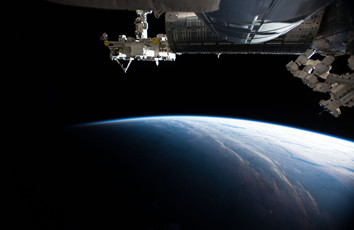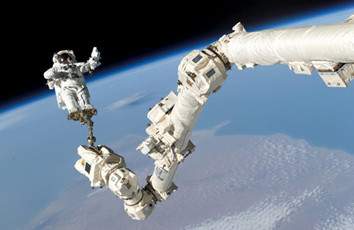3D打印机造出太空人造肉
在宇宙飞船大口吃肉,享用完还可以自己3D打印一份留到下顿,这听着像不像科幻小说的情节?最近,科学家研制出的3D生物打印机就把这一梦想变为现实。
The prospect of astronauts tucking into a roast dinner has grown slightly closer after a successful experiment used a 3D printer to create meat on the International Space Station.
一项使用3D打印机在国际空间站制作肉类的实验成功后,宇航员大吃烤肉的梦想距离实现更近了一步。
The bioprinter produced beef, rabbit and fish tissue using magnetic fields in microgravity, a Russian medical technology company involved in the experiment said last Wednesday.
10月9日,参与实验的一家俄罗斯医疗技术公司表示,这款生物打印机利用微重力环境下的磁场制造出了牛肉、兔子肉和鱼肉组织。

The experiment - an international collaboration involving US, Russian and Israeli companies - was carried out in September by cosmonaut Oleg Skripochka in the station’s Russian segment using a 3D printer developed in Moscow.
今年9月,宇航员奥列格·斯克里波奇卡在国际空间站俄罗斯舱段使用莫斯科研发的3D打印机开展了这一实验。该实验由美国、俄罗斯和以色列公司合作完成。
The creators say it is the first to create a small amount of artificial meat in conditions of weightlessness.
研究人员说,这是首次在失重条件下制造出少量人造肉。
“It’s one small nibble for man, one giant bite for mankind,” said Yusef Khesuani of 3D Bioprinting Solutions, the Russian laboratory that created the bioprinter.
俄罗斯3D生物打印解决方案实验室的尤塞夫·赫苏亚尼说:“这是个人的一小口,人类的一大口。”该实验室正式完成这一试验的生物打印机制造商。
The laboratory was founded by Invitro, a large Russian private medicine company.
该实验室是由俄罗斯大型私营医药公司Invitro成立的。
The Roscosmos space agency part-financed the experiment as of national importance.
俄罗斯联邦航天局也为这项具有国家级重要性的试验资助了部分资金。
“It was really a breakthrough both for Roscosmos and Russia as a whole,” said Nikolai Burdeiny, executive director of the state space corporation, which includes Roscosmos.
俄罗斯联邦航天局所属的俄罗斯国家航天公司的执行董事尼古拉·布尔杰伊尼说:“这对俄罗斯联邦航天局和整个俄罗斯来说都是巨大的突破。”
“For us it was the first experience of international scientific collaboration in space,” Khesuani said, using cells provided by Israeli and US food-tech companies.
赫苏亚尼说:“对我们来说,这是首次在太空开展国际科学合作。”实验用的是以色列和美国食品科技公司提供的细胞。
“Thank God the experiment went successfully... All the cells showed a good result in space,” he added.
他还说:“谢天谢地,试验成功了……所有细胞在太空的试验结果都很好。”

Astronauts eat meat on board that is vacuum-packed or dried on Earth but this technology could ultimately be necessary for long voyages into deep space, said veteran cosmonaut Oleg Kononenko.
资深宇航员奥列格·科诺年科说,宇航员在太空通常吃的是地球上真空包装或脱水的肉类,但这一技术最终可能成为去外层空间远航所必需的技术。
“If we’re going to fly further from Earth to other planets in the solar system, we can't take that volume of food with us,” he told AFP.
他告诉法新社说:“如果我们要从地球飞到太阳系中的其他行星,我们不能带那么多食物。”
“In any case we will have to grow and produce food onboard the spaceship.”
“无论如何,我们都必须在飞船上种植和生产食物。”
“I think progress is developing very quickly, science and knowledge, and I think this will be within our lifetimes,” he said.
他说:“我认为科学和知识进展飞快,在有生之年我们能实现这些目标。”
Creating larger amounts of meat in the Russian segment will need more complex equipment than the current printer, said Khesuani.
赫苏亚尼说,在国际空间站俄罗斯舱段生产更多肉类需要的设备比这台打印机更复杂。
“Then we can create not just small objects but big ones, made of a large mass of cells.”
“随后我们不仅可以制造小块的肉,甚至可以制造出由大量细胞构成的大块肉。”
“I hope we will continue these experiments.”
“我希望这些试验可以继续进行下去。”


